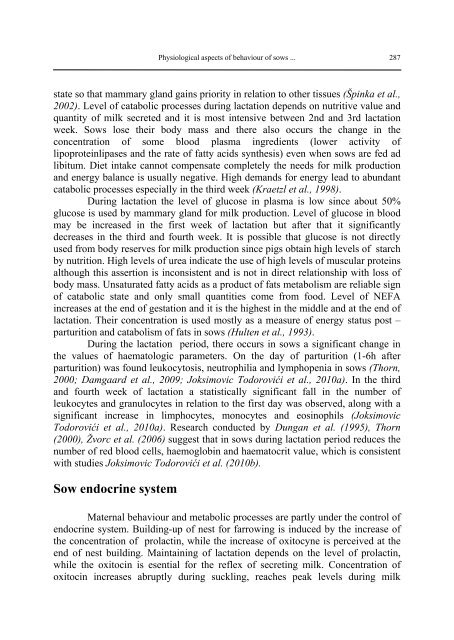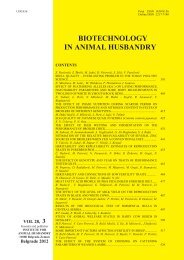Biotechnology in Animal Husbandry - Institut za Stočarstvo
Biotechnology in Animal Husbandry - Institut za Stočarstvo
Biotechnology in Animal Husbandry - Institut za Stočarstvo
You also want an ePaper? Increase the reach of your titles
YUMPU automatically turns print PDFs into web optimized ePapers that Google loves.
Physiological aspects of behaviour of sows ...<br />
state so that mammary gland ga<strong>in</strong>s priority <strong>in</strong> relation to other tissues (Šp<strong>in</strong>ka et al.,<br />
2002). Level of catabolic processes dur<strong>in</strong>g lactation depends on nutritive value and<br />
quantity of milk secreted and it is most <strong>in</strong>tensive between 2nd and 3rd lactation<br />
week. Sows lose their body mass and there also occurs the change <strong>in</strong> the<br />
concentration of some blood plasma <strong>in</strong>gredients (lower activity of<br />
lipoprote<strong>in</strong>lipases and the rate of fatty acids synthesis) even when sows are fed ad<br />
libitum. Diet <strong>in</strong>take cannot compensate completely the needs for milk production<br />
and energy balance is usually negative. High demands for energy lead to abundant<br />
catabolic processes especially <strong>in</strong> the third week (Kraetzl et al., 1998).<br />
Dur<strong>in</strong>g lactation the level of glucose <strong>in</strong> plasma is low s<strong>in</strong>ce about 50%<br />
glucose is used by mammary gland for milk production. Level of glucose <strong>in</strong> blood<br />
may be <strong>in</strong>creased <strong>in</strong> the first week of lactation but after that it significantly<br />
decreases <strong>in</strong> the third and fourth week. It is possible that glucose is not directly<br />
used from body reserves for milk production s<strong>in</strong>ce pigs obta<strong>in</strong> high levels of starch<br />
by nutrition. High levels of urea <strong>in</strong>dicate the use of high levels of muscular prote<strong>in</strong>s<br />
although this assertion is <strong>in</strong>consistent and is not <strong>in</strong> direct relationship with loss of<br />
body mass. Unsaturated fatty acids as a product of fats metabolism are reliable sign<br />
of catabolic state and only small quantities come from food. Level of NEFA<br />
<strong>in</strong>creases at the end of gestation and it is the highest <strong>in</strong> the middle and at the end of<br />
lactation. Their concentration is used mostly as a measure of energy status post –<br />
parturition and catabolism of fats <strong>in</strong> sows (Hulten et al., 1993).<br />
Dur<strong>in</strong>g the lactation period, there occurs <strong>in</strong> sows a significant change <strong>in</strong><br />
the values of haematologic parameters. On the day of parturition (1-6h after<br />
parturition) was found leukocytosis, neutrophilia and lymphopenia <strong>in</strong> sows (Thorn,<br />
2000; Damgaard et al., 2009; Joksimovic Todorovići et al., 2010a). In the third<br />
and fourth week of lactation a statistically significant fall <strong>in</strong> the number of<br />
leukocytes and granulocytes <strong>in</strong> relation to the first day was observed, along with a<br />
significant <strong>in</strong>crease <strong>in</strong> limphocytes, monocytes and eos<strong>in</strong>ophils (Joksimovic<br />
Todorovići et al., 2010a). Research conducted by Dungan et al. (1995), Thorn<br />
(2000), Žvorc et al. (2006) suggest that <strong>in</strong> sows dur<strong>in</strong>g lactation period reduces the<br />
number of red blood cells, haemoglob<strong>in</strong> and haematocrit value, which is consistent<br />
with studies Joksimovic Todorovići et al. (2010b).<br />
Sow endocr<strong>in</strong>e system<br />
Maternal behaviour and metabolic processes are partly under the control of<br />
endocr<strong>in</strong>e system. Build<strong>in</strong>g-up of nest for farrow<strong>in</strong>g is <strong>in</strong>duced by the <strong>in</strong>crease of<br />
the concentration of prolact<strong>in</strong>, while the <strong>in</strong>crease of oxitocyne is perceived at the<br />
end of nest build<strong>in</strong>g. Ma<strong>in</strong>ta<strong>in</strong><strong>in</strong>g of lactation depends on the level of prolact<strong>in</strong>,<br />
while the oxitoc<strong>in</strong> is esential for the reflex of secret<strong>in</strong>g milk. Concentration of<br />
oxitoc<strong>in</strong> <strong>in</strong>creases abruptly dur<strong>in</strong>g suckl<strong>in</strong>g, reaches peak levels dur<strong>in</strong>g milk<br />
287




